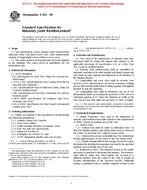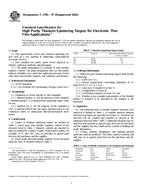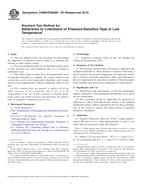1.1 This test method covers the determination of U atom percent fission that has occurred in U fuel from analysis of the 137 Cs to U ratio after irradiation.
1.2 The test method is applicable to high-density, clad U fuel (metal, alloy, ceramic compound) in which no separation of Cs and U has occurred.
1.3 The test method is best applied to fuels that have aged several months since irradiation. In such material, the 13-day 136 Cs activity is reduced to a small amount through decay (3).
1.4 The test method should be restricted to low-exposure samples in which the activity of 134 Cs is less than that of 137 Cs. Cesium-134 is produced by neutron capture on fission product 133 Cs and grows at a rate proportional to the square of the exposure. This capture process limits the test method to samples exposed to less than 0.6 X 10 nvt. This exposure corresponds to burnups of 12 gigawatt days per metric ton of uranium (GWD/MTU) in Yankee Core I, and 5 GWD/ MTU in Dresden Core I. Samples with higher exposures may require the use of a lithium-drifted germanium detector to obtain adequate resolution between 134 Cs and 137 Cs. The use of such a detector will extend the range of this test method by a factor of about 2. Mass spectrometric isotope dilution analysis of 137 Cs with 133 Cs as the isotopic diluent would also overcome 134 Cs interference.
1.5 The test method is best applied to fuels where overheating has not caused center melting or grain growth, since high temperatures cause 137 Cs to distill from the fuel and deposit on cooler regions, such as the cladding. Therefore, cladding should be leached in the dissolver solution or dissolved with the uranium to maintain the true ratio of fission product 137 Cs to U. Alternatively, burnup in a maximum flux region of a fuel element can be obtained from analyzing a low-flux region of the element. The burnup measured in this position can be related to the burnup in the peak-flux position by a gamma scan of the element. A gamma scan usually represents the distribution of zirconium-95 and is a reflection of the fission distribution integrated over only the most recent months. This is not always a serious disadvantage, since such studies may be made after short irradiations.
1.6 This standard does not purport to address all of the safety concerns, if any, associated with its use. It is the responsibility of the user of this standard to establish appropriate safety and health practices and determine the applicability of regulatory limitations prior to use.
Product Details
- Published:
- 01/01/1995
- Number of Pages:
- 4
- File Size:
- 1 file , 25 KB


